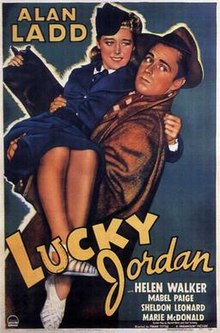
The Blue Dahlia is a 1946 American crime film and film noir with an original screenplay by Raymond Chandler directed by George Marshall and starring Alan Ladd, Veronica Lake and William Bendix. It was Chandler's first original screenplay.
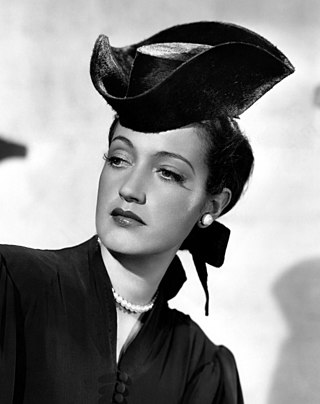
Dorothy Lamour was an American actress and singer. She is best remembered for having appeared in the Road to... movies, a series of successful comedies starring Bing Crosby and Bob Hope.
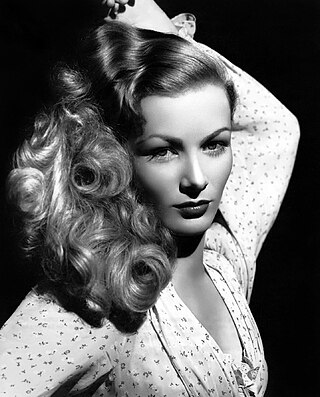
Constance Frances Marie Ockelman, known professionally as Veronica Lake, was an American film, stage, and television actress. Lake was best known for her femme fatale roles in film noirs with Alan Ladd during the 1940s, her peek-a-boo hairstyle, and films such as Sullivan's Travels (1941) and I Married a Witch (1942). By the late 1940s, Lake's career began to decline, due in part to her alcoholism. She made only one film in the 1950s, but made several guest appearances on television. She returned to the big screen in the film Footsteps in the Snow (1966), but the role failed to revitalize her career.
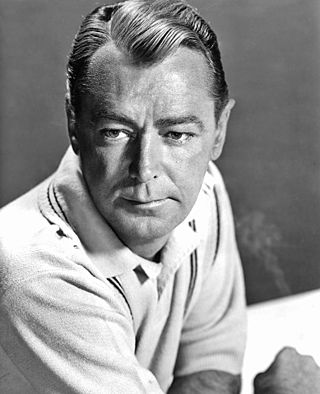
Alan Walbridge Ladd was an American actor and film producer. Ladd found success in film in the 1940s and early 1950s, particularly in films noir and Westerns. He was often paired with Veronica Lake in films noir, such as This Gun for Hire (1942), The Glass Key (1942), and The Blue Dahlia (1946). Whispering Smith (1948) was his first Western and color film, and Shane (1953) was noted for its contributions to the genre. Ladd also appeared in ten films with William Bendix.

Kay Francis was an American stage and film actress. After a brief period on Broadway in the late 1920s, she moved to film and achieved her greatest success between 1930 and 1936, when she was the number one female star and highest-paid actress at Warner Bros. studio. She adopted her mother's maiden name (Francis) as her professional surname.
Richard Maibaum was an American film producer, playwright and screenwriter best known for his screenplay adaptations of Ian Fleming's James Bond novels.
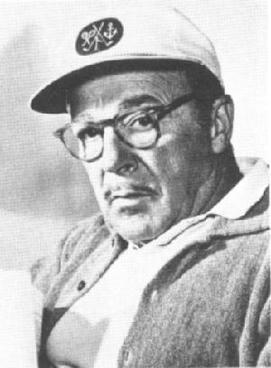
Gordon Douglas Brickner was an American film director and actor, who directed many different genres of films over the course of a five-decade career in motion pictures.

This Gun for Hire is a 1942 American film noir crime film directed by Frank Tuttle and starring Veronica Lake, Robert Preston, Laird Cregar, and Alan Ladd. It is based on the 1936 novel A Gun for Sale by Graham Greene.

Sheldon Leonard Bershad was an American film and television actor, producer, director, and screenwriter.

Helen Marion Walker was an American actress.

Frank Wright Tuttle was a Hollywood film director and writer who directed films from 1922 to 1959.
King Brothers Productions was an American film production company, active from 1941 to the late 1960s. It was founded by the Kozinsky brothers, Morris, Frank, and Hyman, who later changed their professional surname to "King". They had notable collaborations with such filmmakers as Philip Yordan and William Castle and are particularly remembered today for employing a number of blacklisted writers during the Red Scare of the late 1940s and 1950s. Their films include Dillinger (1945), Suspense (1946), Gun Crazy (1949), Carnival Story (1954), The Brave One, Gorgo (1961), Captain Sindbad (1963), and Heaven With a Gun (1968).

The Great Gatsby is a 1949 American historical romance drama film directed by Elliott Nugent, and produced by Richard Maibaum, from a screenplay by Richard Maibaum and Cyril Hume. The film stars Alan Ladd, Betty Field, Macdonald Carey, Ruth Hussey, and Barry Sullivan, and features Shelley Winters and Howard Da Silva, the latter of whom later returned in the 1974 version. It is based on the 1925 novel The Great Gatsby by F. Scott Fitzgerald. Set during the raucous Jazz Age on Long Island near New York City, the plot follows the exploits of enigmatic millionaire and bootlegger Jay Gatsby who attempts to win back the affections of his former lover Daisy Buchanan with the aid of her second cousin Nick Carraway.
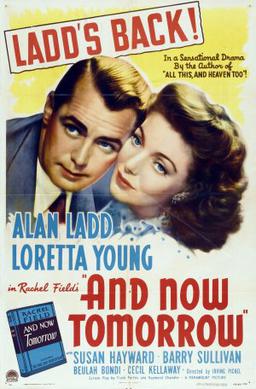
And Now Tomorrow is a 1944 American drama film based on the best-selling novel, published in 1942 by Rachel Field, directed by Irving Pichel and written by Raymond Chandler. Both center around one doctor's attempt for curing deafness. The film stars Alan Ladd, Loretta Young, and Susan Hayward. Its tagline was Who are you that a man can't make love to you?. It is also known as Prisoners of Hope.

O.S.S. is a 1946 American war spy film directed by Irving Pichel and starring Alan Ladd, Geraldine Fitzgerald and Patric Knowles. Produced and distributed by Paramount Pictures, it portrays the activities of the Office of Strategic Services during World War II. The screenplay was written by Richard Maibaum, a World War II veteran who would later write twelve of the first fifteen James Bond films. Maibaum, a former Broadway actor, also narrates the film.

The Glass Key is a 1942 American film noir based on the 1931 novel of the same name by Dashiell Hammett. The picture was directed by Stuart Heisler starring Brian Donlevy, Veronica Lake and Alan Ladd. A successful earlier film version starring George Raft in Ladd's role had been released in 1935. The 1942 version's supporting cast features William Bendix, Bonita Granville, Richard Denning and Joseph Calleia.

Princess O'Rourke is a 1943 American romantic comedy film directed and written by Norman Krasna, and starring Olivia de Havilland, Robert Cummings and Charles Coburn. Krasna won the 1944 Oscar for Best Original Screenplay.

Ghosts on the Loose is a 1943 American comedy horror film and the fourteenth film in the East Side Kids series, directed by William Beaudine. The picture co-stars horror film icon Bela Lugosi as well as Ava Gardner in one of her earliest roles.
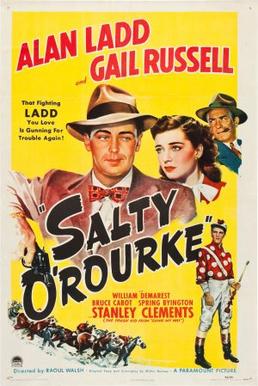
Salty O'Rourke is a 1945 American sports drama film directed by Raoul Walsh and starring Alan Ladd, Gail Russell and William Demarest. Produced and distributed by Paramount Pictures, it was nominated for an Academy Award in 1946.
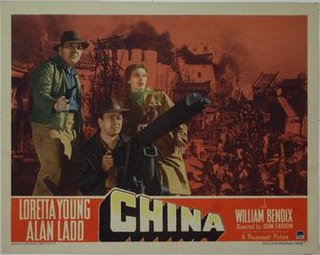
China is a 1943 film directed by John Farrow and starring Loretta Young, Alan Ladd and William Bendix. Ladd's character David Llewellyn Jones, wearing a fedora, a leather jacket, khakis and a beard stubble, was an inspiration for Indiana Jones. Aside from Tala Birell as one of Jones' paramours at the beginning of the film, the entire supporting cast is Asian, including Philip Ahn and Richard Loo.
